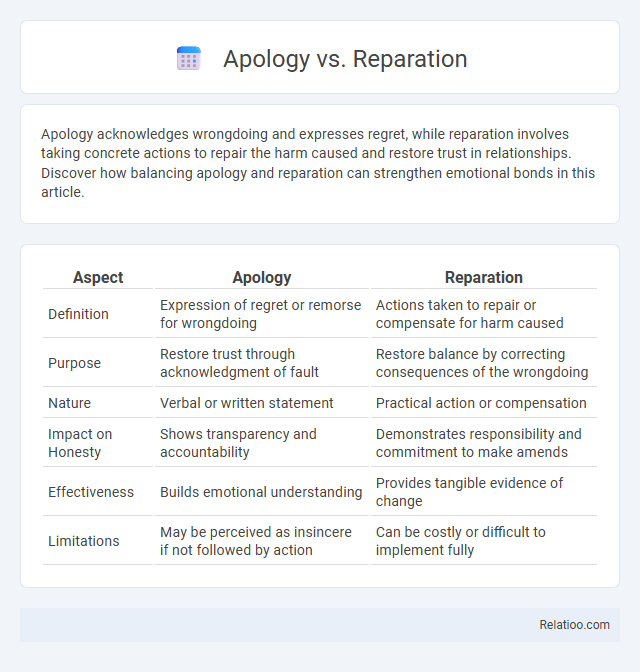Apology acknowledges wrongdoing and expresses regret, while reparation involves taking concrete actions to repair the harm caused and restore trust in relationships. Discover how balancing apology and reparation can strengthen emotional bonds in this article.
Table of Comparison
| Aspect | Apology | Reparation |
|---|---|---|
| Definition | Expression of regret or remorse for wrongdoing | Actions taken to repair or compensate for harm caused |
| Purpose | Restore trust through acknowledgment of fault | Restore balance by correcting consequences of the wrongdoing |
| Nature | Verbal or written statement | Practical action or compensation |
| Impact on Honesty | Shows transparency and accountability | Demonstrates responsibility and commitment to make amends |
| Effectiveness | Builds emotional understanding | Provides tangible evidence of change |
| Limitations | May be perceived as insincere if not followed by action | Can be costly or difficult to implement fully |
Understanding Apology: Definition and Significance
An apology is a verbal expression of regret acknowledging wrongdoing or hurt caused, serving as a fundamental step in conflict resolution and emotional healing. Its significance lies in validating the feelings of the aggrieved party and fostering trust rebuilding, which is crucial for restoring relationships. Unlike reparation, which involves material or financial compensation, an apology primarily addresses the emotional and ethical aspects of reconciliation.
What Constitutes a True Reparation?
A true reparation involves not only acknowledging wrongdoing through an apology but also actively restoring the harm caused by offering compensation or corrective measures. Unlike a simple apology, which expresses regret, reparation requires tangible actions such as financial restitution, policy changes, or community investments that directly address the damage inflicted. Genuine reparations must be comprehensive, incorporating both emotional acknowledgment and material redress to achieve meaningful justice and reconciliation.
Key Differences Between Apology and Reparation
Apology involves expressing regret and acknowledging wrongdoing, emphasizing verbal or written statements to mend relationships. Reparation refers to making amends through compensation, restoration, or corrective actions addressing harm caused. The key difference lies in apology focusing on emotional and moral acknowledgment, while reparation entails tangible efforts to repair damage or loss.
Psychological Impact: Apology vs Reparation
Apologies provide immediate psychological relief by acknowledging hurt and validating emotions, fostering forgiveness and emotional healing. Reparations, often tangible or compensatory actions, address long-term psychological impact by restoring trust and reducing feelings of injustice or resentment. Both apology and reparation play distinct yet complementary roles in psychological recovery from harm or trauma.
Legal Perspectives: Apologies and Reparation in Law
Apology in legal contexts serves as an acknowledgment of wrongdoing without necessarily implying liability, often used to restore relationships and mitigate damages. Reparation involves compensating victims through monetary payments or other forms to address harm caused and fulfill justice requirements. Your understanding of these concepts influences how legal systems balance accountability, healing, and restitution in resolving disputes.
Social and Cultural Contexts in Apology and Reparation
Apology and reparation serve distinct roles in social and cultural contexts, where an apology involves acknowledging wrongdoing and expressing regret, while reparation entails compensating for harm caused. Socially, apologies can restore relationships by affirming respect and empathy, whereas reparations address tangible damages or injustices, often requiring systemic or material restitution. Your understanding of these concepts deepens when recognizing that effective reconciliation may depend on combining sincere apologies with meaningful reparations tailored to cultural values and historical experiences.
The Role of Sincerity in Making Amends
Sincerity plays a crucial role in distinguishing apologies, reparations, and forgiveness in the process of making amends. An apology expresses genuine remorse and acknowledges wrongdoing, while reparations involve tangible actions or compensation to address harm caused. Forgiveness depends on the perceived sincerity of both the apology and reparative efforts, fostering trust and emotional healing between parties.
Apology and Reparation: Which Comes First?
An apology serves as the initial step in acknowledging wrongdoing and expressing sincere remorse, establishing an emotional connection that validates the affected party's feelings. Reparations involve concrete actions or compensation aimed at rectifying harm and restoring justice, which build trust and demonstrate accountability following an apology. You benefit most when apologies and reparations are thoughtfully sequenced, ensuring genuine acknowledgment precedes meaningful restitution.
Case Studies: Effective Apologies and Reparations
Case studies reveal that effective apologies and reparations significantly impact healing in post-conflict societies, such as South Africa's Truth and Reconciliation Commission, where public acknowledgments of wrongdoing fostered national healing. Japan's reparations to World War II survivors demonstrate how material compensation can support victims' recovery, though without a sincere apology, the process may lack complete closure. Your understanding of these examples highlights that combining heartfelt apologies with tangible reparations creates a comprehensive approach to justice and reconciliation.
Moving Forward: Integrating Apology and Reparation for Lasting Resolution
Moving forward requires integrating apology and reparation to achieve lasting resolution, where apology acknowledges harm and expresses remorse, while reparation provides tangible restitution or compensation. Your ability to combine sincere acknowledgment with meaningful actions fosters trust restoration and emotional healing. Effective resolution depends on balancing these elements to address both emotional and material aspects of harm.

Infographic: Apology vs Reparation
 relatioo.com
relatioo.com